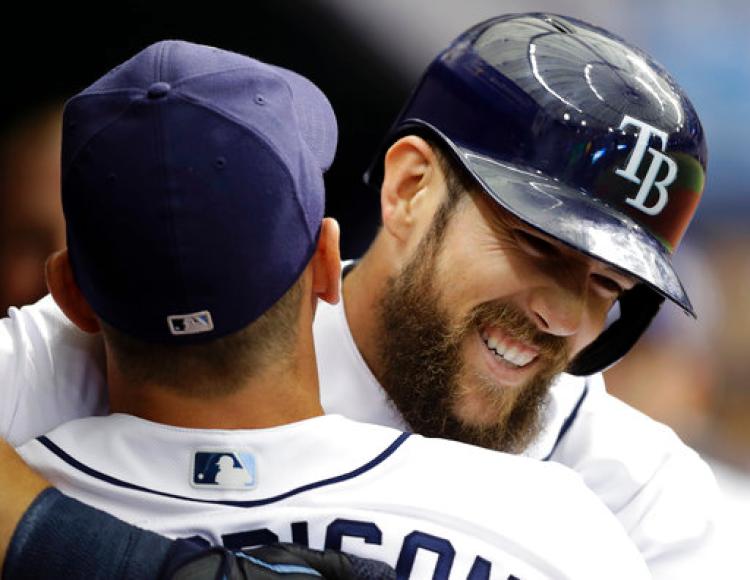
Here we are, about a month into the season, and most of the everyday players in the Tampa Bay Rays lineup have racked up anywhere between 51 and 99 plate appearances. While it is easy to look at a particular player’s batting average and conclude that he is performing at a certain level, be that good or bad, only one statistic offers a valid measurement at this point in the season — strikeout rate (K%).
Allow me to expand on the subject.
Strikeout percentage is a statistic based on total plate appearances. It can be used to make inferences about a player based on a certain sample size — in this case 60 plate appearances, when strikeout rates tend to stabilize. To put things in perspective, beyond the watermark of 60 plate appearances, it is unlikely that a player’s strikeout percentage is based solely on random variation.
It is, typically, the first statistic to be analyzed because of the incredibly small sample size needed to accrue information. Walk percentage follows, stabilizing at 120 plate appearances, while home run rate stabilizes at 170 plate appearances — so on and so forth. You can read an excellent article on statistics and sample size at Baseball Prospectus.
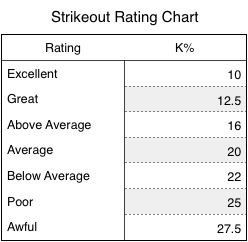
Note: The chart above is meant to be used as an estimate. League-average strikeout rates vary on a year-by-year basis.
The question begs, how are the everyday players on the Rays’ roster looking so far? Let’s take a look.
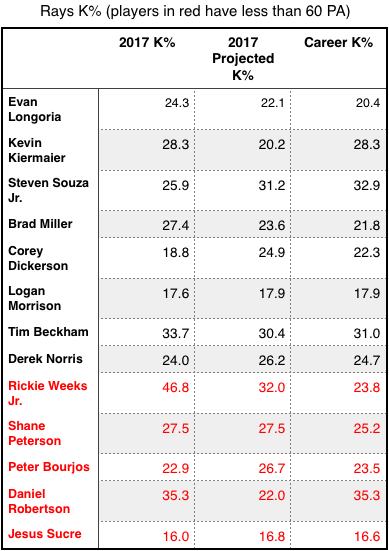
The above average to average — Logan Morrison, Corey Dickerson and Jesus Sucre
By this point last season, Logan Morrison had struck out a gaudy 39.1% of the time. Thankfully, as of now, he has reduced that rate by 22+ points and is fanning just under his career norm. After cooling down from a torrid start to the season, Morrison has been more successful in 2017 than last season, something he attributes to not over thinking things. LoMo spoke with David Laurila (FanGraphs) recently, saying that he looks to barrel up balls in the zone, while attempting to lay off pitches down in the zone:
To me, (plate discipline) is a plane thing. Does that make sense? As a hitter, you want to hit the ball up. You want the ball middle. But, at the same time, if the ball starts middle, it’s never going to end up middle. Maybe sometimes, but not usually. Getting it up, and seeing it on that plane, helps you put the barrel on the ball. If it’s down… you might take some strikes at the bottom of the zone, but a lot of times they’re trying to get you out underneath the zone. It helps to lay off that stuff.
“As far as (pitch location), I’m more of a up-and-middle, middle-away guy. I just think there’s a lot of stuff down and in that can get you out if you’re actually looking there. It’s a reaction pitch. If you’re able to react to that, and it’s a strike, you can do damage with it, no doubt. But again, there’s a lot of stuff down there that goes out of the zone. You swing over those.
Thus far, Corey Dickerson has swung a steady bat at the top of the order, lowering his strikeout rate by 5% between this season and last. The key to his successful, hot start? Swing at stuff in the zone, or just on the fringes.
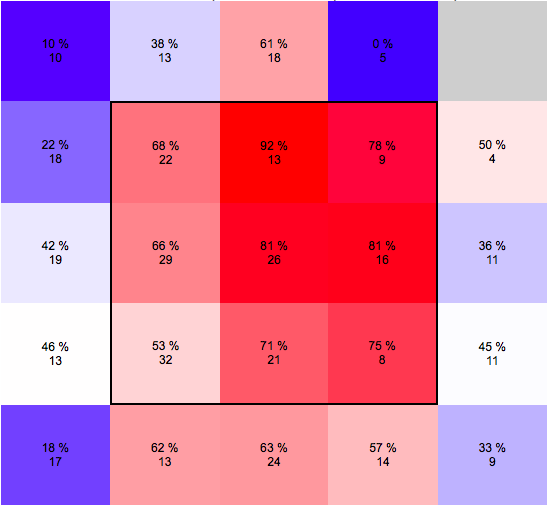
Sucre has always been a contact hitter with a low K%, this season being no different from the rest in that respect. However, with just 25 plate appearances under his belt, the incredibly small sample size makes it hard to determine whether he has stabilized or not.
The worrisome — Evan Longoria, Kevin Kiermaier, Steven Souza Jr., Tim Beckham and Rickie Weeks Jr.
After posting a 21% strikeout rate last season, Evan Longoria has put up a 24.3% strikeout rate so far — the highest since his rookie campaign. Moreover, Longoria’s overall offensive rating sits at -1.1. While his walk rate is up, it’s a tad worrisome that he’s swinging through pitches in the zone.
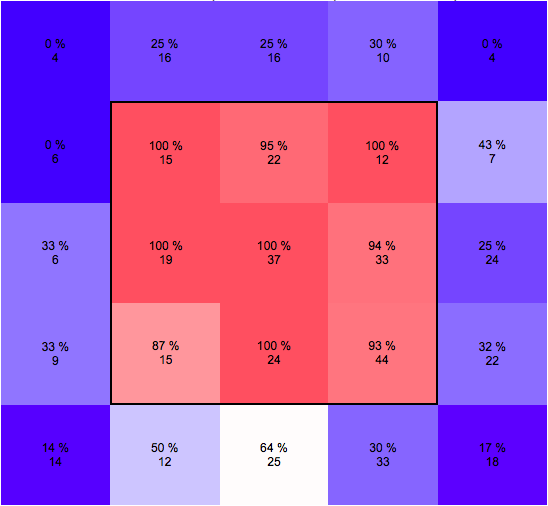
I wrote this about Souza last season:
Despite striking out 35.4% of the time, Steven Souza Jr. has been productive at the plate, collecting five homers and 11 RBI. He’s also lowered his strikeout percentage from this point last season. Still, he was projected for a 31.5% strikeout percentage this season by ZiPS. It certainly doesn’t help that he’s struck out seven times in his last 16 plate appearances, while collecting just two hits in that span.
Well, Souza has lowered his strikeout rate significantly, and he’s also been one of the Rays most productive hitters in the early going. The biggest reason behind Souza’s improvement? His batting eye. While he typically has an above average walk rate, Souza has further improved. What’s more, his swinging strike rate (SwStr%) has dipped, too, from 15% to 12%. I know what you’re thinking; a 25.9% strikeout rate is worrisome. However, compared to his past numbers, I’ll gladly take it and his production any day of the week.
At this point last season, Brad Miller had a 26.8% strikeout rate to his name. By the end of the season though, he lowered that to 24.8%. He’s still exceeding both his career norms and his 2017 projections, although his 2017 production through April is better than that of last season. Interestingly enough, Miller has struck out more on the road (16 times) than at home (8 times).
The more egregious of the dynamic duo, that is Tim Beckham and Rickie Weeks Jr., is the latter. If a 27% K% is awful, I’m not really sure how to quantify 46.8%. Abysmal? Horrendous? Whatever the case, of the Rays 10 strikeouts on April 30, four came from Weeks. I was fan of his signing, although I’m big enough to admit when I’m wrong, and…well…things haven’t worked out for the better. Weeks has fared well against lefties, to the tune of 129 wRC+. However, his 51 wRC+ against righties is the personification of a fart on a snare drum. To put it another way, Weeks stepped to the plate Monday night with the bases loaded and two out, and swung through Junichi Tazawa’s 94 mph fastball that was well off the plate.
Conclusion
The team, as a whole, has posted a 25.9% strikeout percentage — tied with Milwaukee for the highest K% in all of baseball. That number is largely due to their aggressive 46.5% swing percentage (67.9% Z-Swing%). A free swinging team is one that hits a lot of homers, yet also strikes out at an uncomfortable pace. Pick your poison.
To be clear, strikeout percentage (as with any other statistic) is fluid and can change for better or worse. It can decrease when a batter makes the proper adjustments at the plate. Be that as it may, in order for Longoria, Kiermaier, Beckham and Weeks to be important contributors to the team, those adjustments will need to be made.
